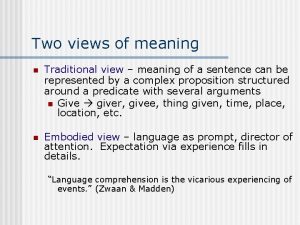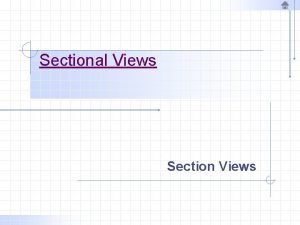CONFLICT Traditional and Current Views of Conflict 2















- Slides: 15

CONFLICT

Traditional and Current Views of Conflict 2. Traditional View Conflict is avoidable. Conflict is caused by management error in designing organizations or by trouble makers. 3. Conflict disrupts the organization 1. 4. 5. The task of the management is to conflict. Optimal organizational performance requires the removal of conflict. Current View 1. Conflict is inevitable. 2. Conflict arises from many causes, including organizational structure, unavoidable differences in goals, differences in perceptions and values of specialized personnel and so on. 3. Conflict contributes in optimal performance. organizational performance in varying degrees. 4. The task of the management is to eliminate manage the level of conflict and its resolution for optimal organizational performance. 5. Optimal organizational performance requires a moderate level of conflict.

Relation Between Organisational Performance and Conflict

Positive and Negative Conflict • • • Positive Increased involvement Increased cohesion Increased innovation and creativity Personal growth and change Clarification of key issues Organizational vibrancy Individual and group identities • • • Negative Unresolved anger Personality clashes Less self-esteem Inefficiency Diversion of energy from work Psychological well being threatened • Wastage of resources Negative climate Group cohesion disrupted.

Stages of Conflict

Levels and Sources of Conflict

Antecedents of Conflict • Incompatible personalities or value systems • • • Overlapping or unclear job boundaries Competition for limited resources Inadequate communication Interdependent tasks Organisational complexity (conflict tends to incrase as the number of hierarchical layers and specialised tasks increase) Unreasonable or unclear policies, standards, or rules Unreasonable deadline or extreme time pressure Collective decision making (the greater the number of people participating in a decision, the greater the potential for conflict) Decision making by consensus Unmet expectations (employees who have unrealistic expectations about job assisgnments, pay, or promotions are more prone to conflict) Unresolved or suppressed conflict

Approach-Approach Conflict

Approach-Avoidance Conflict Avoidance-Avoidance Conflict

Merits and Demerits of TA The bases of TA are simple to learn. (ii) The validity of TA is demonstrable. (ii) It provides a means for reducing the amount of bad feelings experienced by an individual. (iii) It increases efficient use of time. (iv) Helps promote effective communication (v) It is applicable at home as it is at work. (vi) It reinforces and implements other management development activities, including communication, leadership, brainstorming, management by objective, job enrichment, conflict resolution, and the like. 16 TA has certain limitations which are not to be ignored. They are: (i) Few scientific studies of its outcome are available (ii) Ego states, basic to understand utilize TA, are difficult to define (although easy to teach and demonstrate operationally). (iii) If inappropriately applied, TA tends to encourage “amateur psychologising. ” (iv) TA jargon may lead to more “cuteness” than insight into human encounter. (v) It can be used as a put down, or a discount, in inter-personal relations. (i)

Johari Window

Types of Task Interdependence

"Tell him that I sincerely apologize for grabbing him by the hair, and beating his head on the negotiating table. "

Strategies for Resolving Conflict

Conflict-resolution techniques
 Traditional view meaning
Traditional view meaning Ea blueprint
Ea blueprint Line current and phase current
Line current and phase current Difference between phase voltage and line voltage
Difference between phase voltage and line voltage Semiconductor
Semiconductor Ac theory 3 lesson 4
Ac theory 3 lesson 4 Drift current density unit
Drift current density unit Intrinsic semiconductor
Intrinsic semiconductor In a triangle connected source feeding a y connected load
In a triangle connected source feeding a y connected load Holding current and latching current
Holding current and latching current Diffusion current density
Diffusion current density Q point
Q point The shielded metal arc welding machines voltage output
The shielded metal arc welding machines voltage output Hazard based safety engineering
Hazard based safety engineering Mesh current method with current source
Mesh current method with current source Whats an external conflict
Whats an external conflict





























